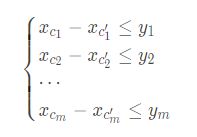【模板】差分约束算法(两种方法)
【模板】差分约束算法 \operatorname{【模板】差分约束算法} 【模板】差分约束算法
题目链接: luogu P5960 \operatorname{luogu\ P5960} luogu P5960
题目
给出一组包含 m m m 个不等式,有 n n n 个未知数的形如:

的不等式组,求任意一组满足这个不等式组的解。
输入
第一行为两个正整数 n , m n,m n,m,代表未知数的数量和不等式的数量。
接下来 m m m 行,每行包含三个整数 c , c ′ , y c,c',y c,c′,y,代表一个不等式 x c − x c ′ ≤ y x_c-x_{c'}\leq y xc−xc′≤y。
输出
一行, n n n 个数,表示 x 1 , x 2 ⋯ x n x_1 , x_2 \cdots x_n x1,x2⋯xn 的一组可行解,如果有多组解,请输出任意一组,无解请输出 NO。
样例输入
3 3
1 2 3
2 3 -2
1 3 1
样例输出
5 3 5
样例解释

一种可行的方法是 x 1 = 5 , x 2 = 3 , x 3 = 5 x_1 = 5, x_2 = 3, x_3 = 5 x1=5,x2=3,x3=5。

数据范围
对于 100 % 100\% 100% 的数据, 1 ≤ n , m ≤ 5 × 1 0 3 1\leq n,m \leq 5\times 10^3 1≤n,m≤5×103, − 1 0 4 ≤ y ≤ 1 0 4 -10^4\leq y\leq 10^4 −104≤y≤104, 1 ≤ c , c ′ ≤ n 1\leq c,c'\leq n 1≤c,c′≤n, c ≠ c ′ c \neq c' c=c′。
评分标准
你的答案符合该不等式组即可得分,请确保你的答案中的数据在 int 范围内。
如果并没有答案,而你的程序给出了答案,SPJ 会给出 There is no answer, but you gave it,结果为 WA;
如果并没有答案,而你的程序输出了 NO,SPJ会给出 No answer,结果为 AC;
如果存在答案,而你的答案错误,SPJ 会给出 Wrong answer,结果为 WA;
如果存在答案,且你的答案正确,SPJ 会给出 The answer is correct,结果为 AC。
思路
一道模板题。
差分约束就是给你许多不等式,你要在这些约束下,找到一组解。
我们来看不等式: x 1 − x 2 ≤ y 1 x_1-x_2\leq y_1 x1−x2≤y1
这时候有两个选择:
(代码我写的是最长路的,因为最短路代码没有太大区别,我就直接在要改的地方加注释)
最长路
我们可以把它化成这个式子: x 2 ≥ x 1 − y 1 x_2\geq x_1-y_1 x2≥x1−y1
我们再想一想最长路,可以发现最后求出来的 d i s [ y ] ≥ d i s [ x ] + w x , i dis[y]\geq dis[x]+w_{x,i} dis[y]≥dis[x]+wx,i。( w x , i w_{x,i} wx,i 就是从 x x x 到 y y y 的每一条边)
诶?怎么跟上面的式子那么像!
(边权可以是 − y 1 -y_1 −y1)
那其实我们就可以按这样建图,然后跑最长路,可以发现没有解就是存在正环的情况。
当然为了避免不连通,我们还弄一个超级源点,连向所有点,距离为 0 0 0。
最短路
当然,我们还能化成这个: x 1 ≤ x 2 + y 1 x_1\leq x_2+y_1 x1≤x2+y1
当然就是和最短路匹配了,没有解就是存在负环,当然也要弄源点。
代码(最长路)
#include